Poole Ch.P., Jr. Handbook of Superconductivity
Подождите немного. Документ загружается.

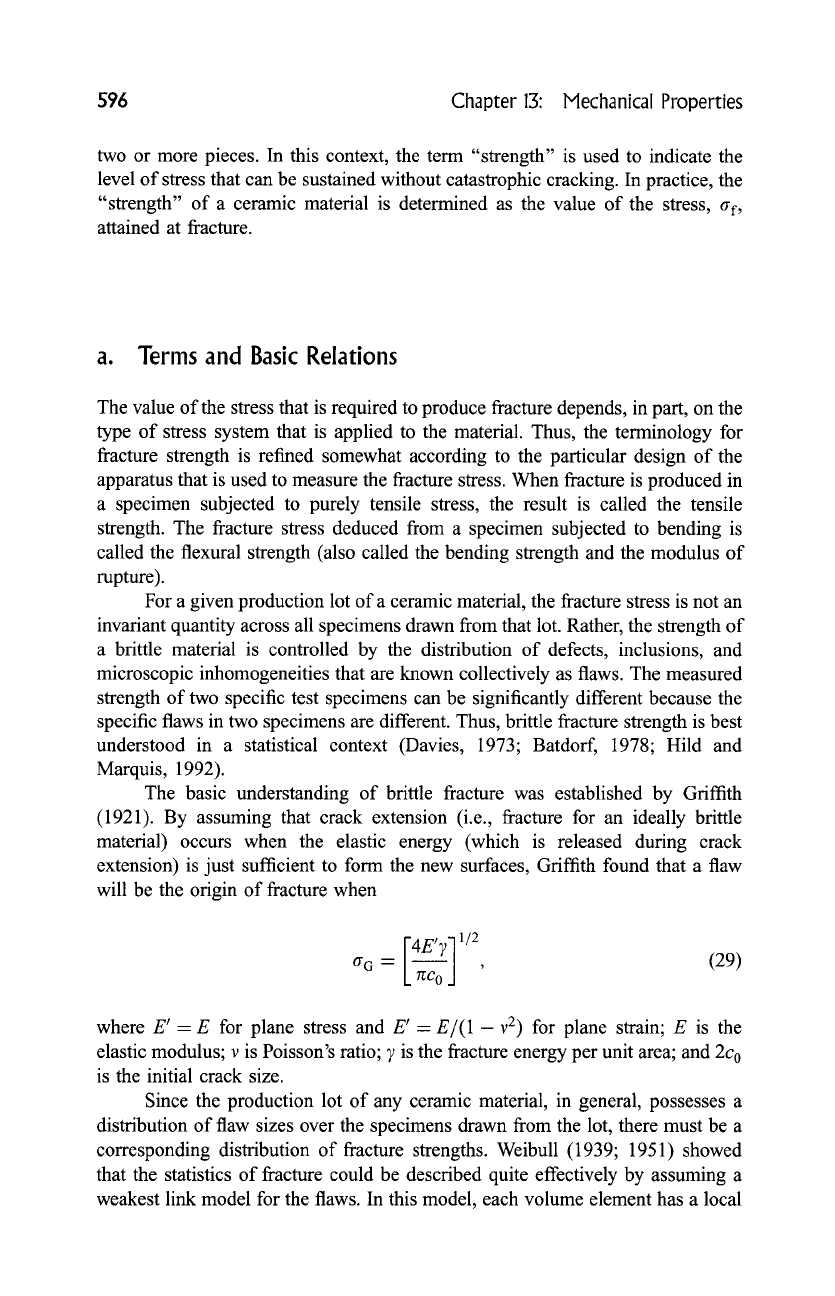
596
Chapter
13:
Mechanical Properties
two or more pieces. In this context, the term "strength" is used to indicate the
level of stress that can be sustained without catastrophic cracking. In practice, the
"strength" of a ceramic material is determined as the value of the stress, af,
attained at fracture.
a. Terms and Basic Relations
The value of the stress that is required to produce fracture depends, in part, on the
type of stress system that is applied to the material. Thus, the terminology for
fracture strength is refined somewhat according to the particular design of the
apparatus that is used to measure the fracture stress. When fracture is produced in
a specimen subjected to purely tensile stress, the result is called the tensile
strength. The fracture stress deduced from a specimen subjected to bending is
called the flexural strength (also called the bending strength and the modulus of
rupture).
For a given production lot of a ceramic material, the fracture stress is not an
invariant quantity across all specimens drawn from that lot. Rather, the strength of
a brittle material is controlled by the distribution of defects, inclusions, and
microscopic inhomogeneities that are known collectively as flaws. The measured
strength of two specific test specimens can be significantly different because the
specific flaws in two specimens are different. Thus, brittle fracture strength is best
understood in a statistical context (Davies, 1973; Batdorf, 1978; Hild and
Marquis, 1992).
The basic understanding of brittle fracture was established by Griffith
(1921). By assuming that crack extension (i.e., fracture for an ideally brittle
material) occurs when the elastic energy (which is released during crack
extension) is just sufficient to form the new surfaces, Griffith found that a flaw
will be the origin of fracture when
a c - , (29)
L rcc0 1
where E'= E for plane stress and E'=
E/(1-
y2)
for plane strain; E is the
elastic modulus; v is Poisson's ratio; 7 is the fracture energy per unit area; and 2c 0
is the initial crack size.
Since the production lot of any ceramic material, in general, possesses a
distribution of flaw sizes over the specimens drawn from the lot, there must be a
corresponding distribution of fracture strengths. Weibull (1939; 1951) showed
that the statistics of fracture could be described quite effectively by assuming a
weakest link model for the flaws. In this model, each volume element has a local
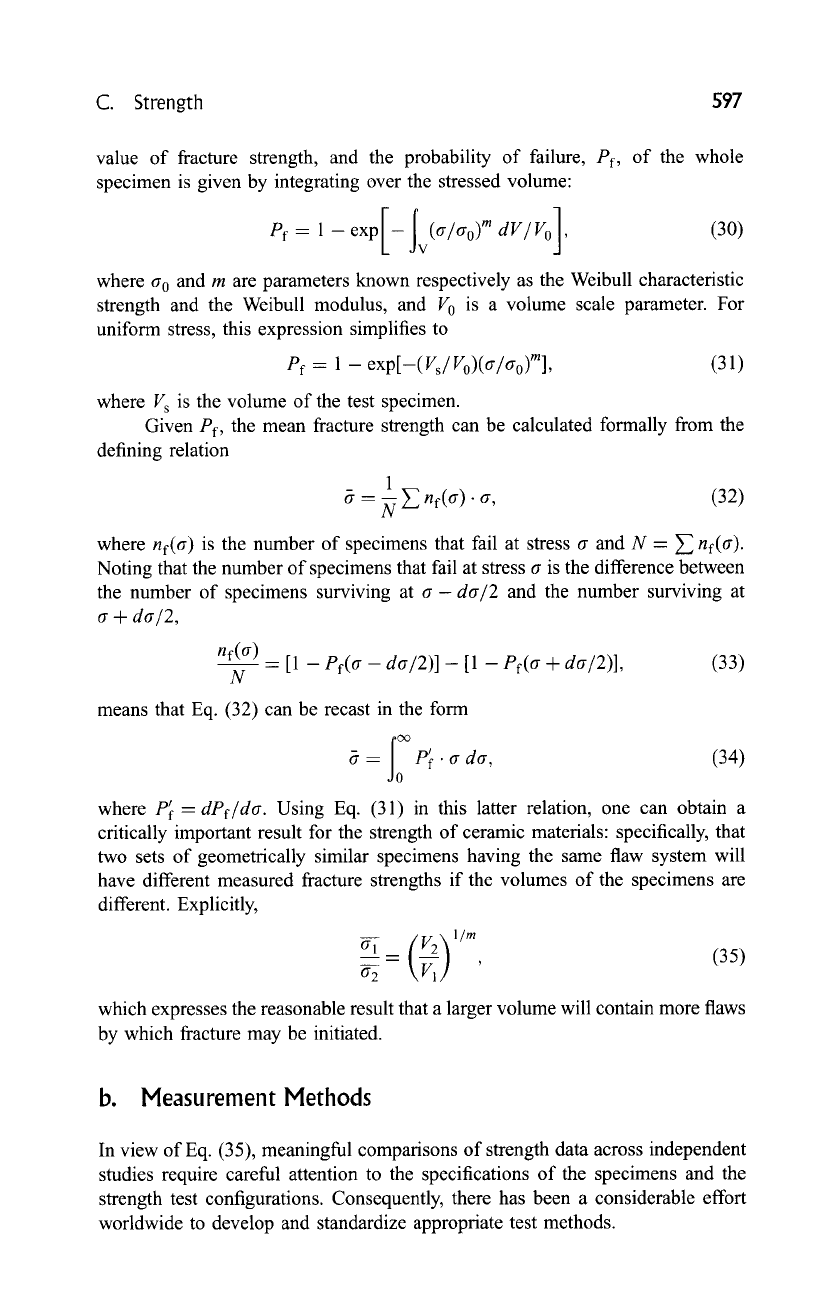
C. Strength 597
value of fracture strength, and the probability of failure,
Pf,
of the whole
specimen is given by integrating over the stressed volume:
Pf -1-expI-Iv(a/Oo)mdV/Vo],
(30)
where a 0 and m are parameters known respectively as the Weibull characteristic
strength and the Weibull modulus, and V 0 is a volume scale parameter. For
uniform stress, this expression simplifies to
Pf = 1 -- exp[-(Vs/Vo)(a/ao)m],
(31)
where V s is the volume of the test specimen.
Given Pf, the mean fracture strength can be calculated formally from the
defining relation
1
O" -- N E nf(o') 9 0",
(32)
where
nf(o)
is the number of specimens that fail at stress a and N- ~
nf(o).
Noting that the number of specimens that fail at stress a is the difference between
the number of specimens surviving at
a- da/2
and the number surviving at
a + da/2,
nf(o)
N
-- = [1 - Pf(a -
da/2)] -
[1 - Pf(a +
da/2)],
means that Eq. (32) can be recast in the form
6" - P'f . a da,
(33)
(34)
where
Uf- dPf/da.
Using Eq. (31) in this latter relation, one can obtain a
critically important result for the strength of ceramic materials: specifically, that
two sets of geometrically similar specimens having the same flaw system will
have different measured fracture strengths if the volumes of the specimens are
different. Explicitly,
(71 (_~11) 1/m
- , (35)
O" 2
which expresses the reasonable result that a larger volume will contain more flaws
by which fracture may be initiated.
b. Measurement Methods
In view of Eq. (35), meaningful comparisons of strength data across independent
studies require careful attention to the specifications of the specimens and the
strength test configurations. Consequently, there has been a considerable effort
worldwide to develop and standardize appropriate test methods.
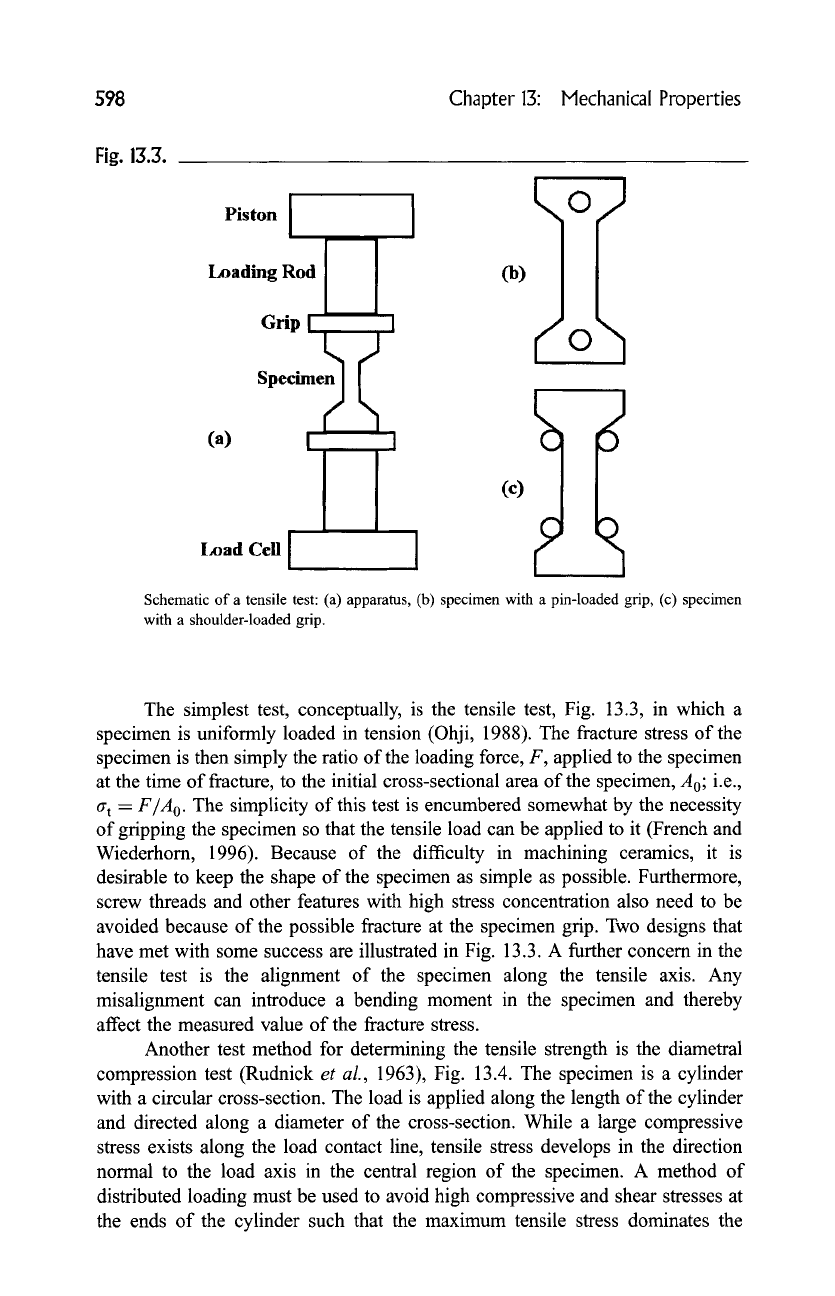
Fig. 13.3.
Piston
Co)
Loadin~ R~---~rip
Specim
(a)
Load Cr
I
598 Chapter 13: Mechanical Properties
(c)
Schematic of a tensile test: (a) apparatus, (b) specimen with a pin-loaded grip, (c) specimen
with a shoulder-loaded grip.
The simplest test, conceptually, is the tensile test, Fig. 13.3, in which a
specimen is uniformly loaded in tension (Ohji, 1988). The fracture stress of the
specimen is then simply the ratio of the loading force, F, applied to the specimen
at the time of fracture, to the initial cross-sectional area of the specimen, A0; i.e.,
at = F/Ao.
The simplicity of this test is encumbered somewhat by the necessity
of gripping the specimen so that the tensile load can be applied to it (French and
Wiederhorn, 1996). Because of the difficulty in machining ceramics, it is
desirable to keep the shape of the specimen as simple as possible. Furthermore,
screw threads and other features with high stress concentration also need to be
avoided because of the possible fracture at the specimen grip. Two designs that
have met with some success are illustrated in Fig. 13.3. A further concern in the
tensile test is the alignment of the specimen along the tensile axis. Any
misalignment can introduce a bending moment in the specimen and thereby
affect the measured value of the fracture stress.
Another test method for determining the tensile strength is the diametral
compression test (Rudnick
et al.,
1963), Fig. 13.4. The specimen is a cylinder
with a circular cross-section. The load is applied along the length of the cylinder
and directed along a diameter of the cross-section. While a large compressive
stress exists along the load contact line, tensile stress develops in the direction
normal to the load axis in the central region of the specimen. A method of
distributed loading must be used to avoid high compressive and shear stresses at
the ends of the cylinder such that the maximum tensile stress dominates the
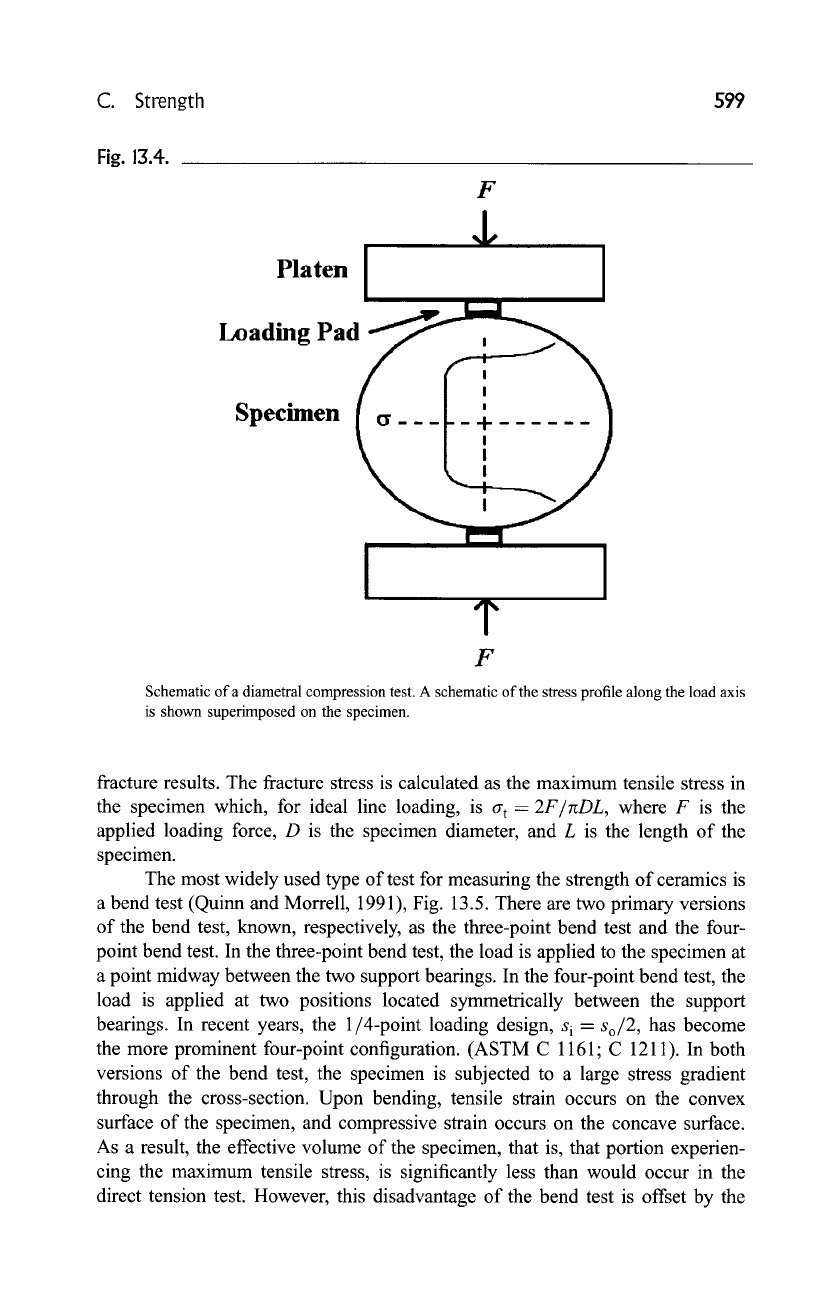
C. Strength 599
Fig. 13.4.
Platen
F
J,
Loading Pad
Specimen | ~_ __
I
I
!
-4
I
I
I
F
Schematic of a diametral compression test. A schematic of the stress profile along the load axis
is shown superimposed on the specimen.
fracture results. The fracture stress is calculated as the maximum tensile stress in
the specimen which, for ideal line loading, is at =
2F/nDL,
where F is the
applied loading force, D is the specimen diameter, and L is the length of the
specimen.
The most widely used type of test for measuring the strength of ceramics is
a bend test (Quinn and Morrell, 1991), Fig. 13.5. There are two primary versions
of the bend test, known, respectively, as the three-point bend test and the four-
point bend test. In the three-point bend test, the load is applied to the specimen at
a point midway between the two support beatings. In the four-point bend test, the
load is applied at two positions located symmetrically between the support
beatings. In recent years, the 1/4-point loading design, s i =
So~2,
has become
the more prominent four-point configuration. (ASTM C 1161; C 1211). In both
versions of the bend test, the specimen is subjected to a large stress gradient
through the cross-section. Upon bending, tensile strain occurs on the convex
surface of the specimen, and compressive strain occurs on the concave surface.
As a result, the effective volume of the specimen, that is, that portion experien-
cing the maximum tensile stress, is significantly less than would occur in the
direct tension test. However, this disadvantage of the bend test is offset by the
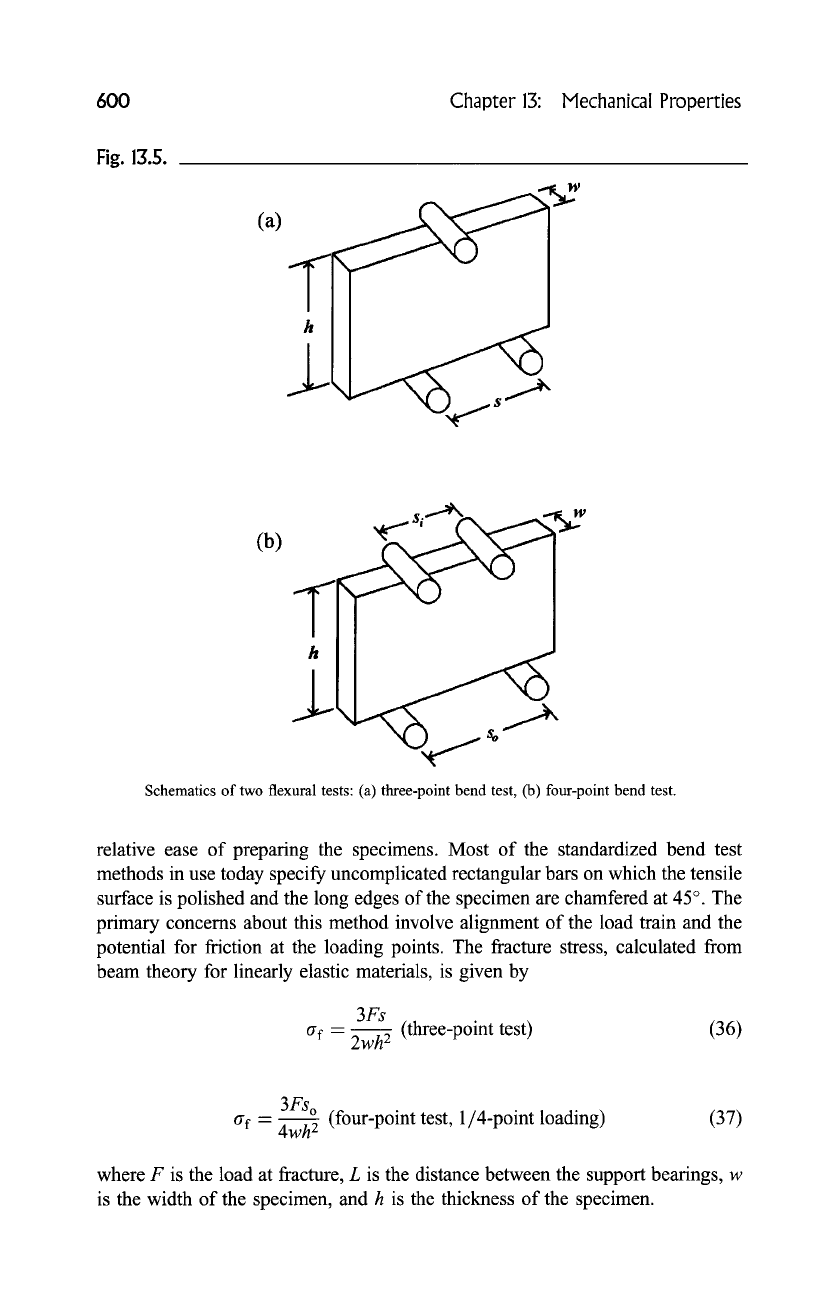
600
Chapter
13:
Mechanical Properties
Fig. 13.5.
(a)
(b)
h
L
) /so"
Schematics of two flexural tests: (a) three-point bend test, (b) four-point bend test.
relative ease of preparing the specimens. Most of the standardized bend test
methods in use today specify uncomplicated rectangular bars on which the tensile
surface is polished and the long edges of the specimen are chamfered at 45 ~ . The
primary concerns about this method involve alignment of the load train and the
potential for friction at the loading points. The fracture stress, calculated from
beam theory for linearly elastic materials, is given by
3Fs
tYf "--
2wh2
(three-point test) (36)
3Fs~
(four-point test,
1/4-point
loading)
ff f - 4wh2
(37)
where F is the load at fracture, L is the distance between the support beatings, w
is the width of the specimen, and h is the thickness of the specimen.
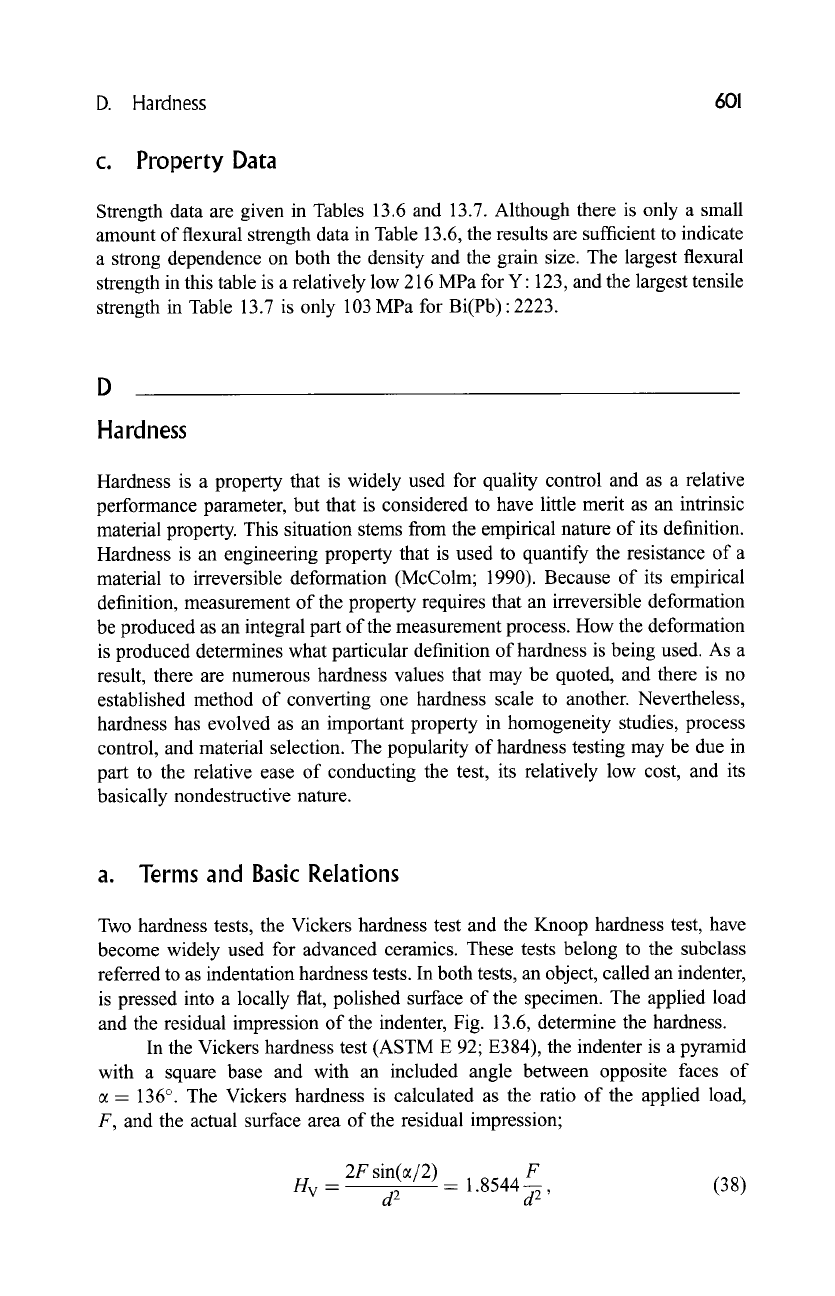
O. Hardness 601
c. Property Data
Strength data are given in Tables 13.6 and 13.7. Although there is only a small
amount of flexural strength data in Table 13.6, the results are sufficient to indicate
a strong dependence on both the density and the grain size. The largest flexural
strength in this table is a relatively low 216 MPa for Y: 123, and the largest tensile
strength in Table 13.7 is only 103 MPa for Bi(Pb) : 2223.
D
Hardness
Hardness is a property that is widely used for quality control and as a relative
performance parameter, but that is considered to have little merit as an intrinsic
material property. This situation stems from the empirical nature of its definition.
Hardness is an engineering property that is used to quantify the resistance of a
material to irreversible deformation (McColm; 1990). Because of its empirical
definition, measurement of the property requires that an irreversible deformation
be produced as an integral part of the measurement process. How the deformation
is produced determines what particular definition of hardness is being used. As a
result, there are numerous hardness values that may be quoted, and there is no
established method of converting one hardness scale to another. Nevertheless,
hardness has evolved as an important property in homogeneity studies, process
control, and material selection. The popularity of hardness testing may be due in
part to the relative ease of conducting the test, its relatively low cost, and its
basically nondestructive nature.
a. Terms and Basic Relations
Two hardness tests, the Vickers hardness test and the Knoop hardness test, have
become widely used for advanced ceramics. These tests belong to the subclass
referred to as indentation hardness tests. In both tests, an object, called an indenter,
is pressed into a locally flat, polished surface of the specimen. The applied load
and the residual impression of the indenter, Fig. 13.6, determine the hardness.
In the Vickers hardness test (ASTM E 92; E384), the indenter is a pyramid
with a square base and with an included angle between opposite faces of
= 136 ~ The Vickers hardness is calculated as the ratio of the applied load,
F, and the actual surface area of the residual impression;
2F sin(~/2) F
H v = d2 = 1.8544 d- 5 , (38)
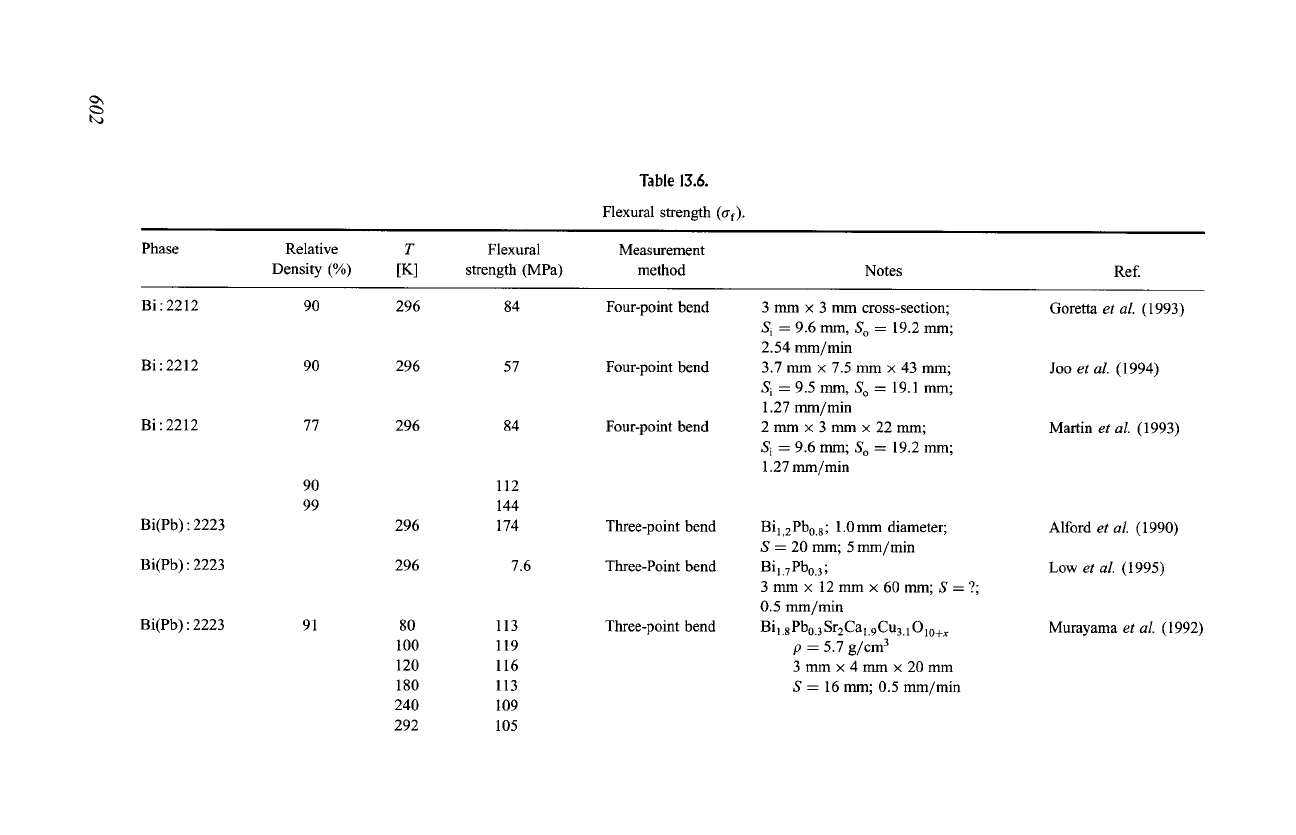
t,,a
Table 13.6.
Flexural strength (o-f).
Phase
Relative
Density (%)
T
[K]
Flexural
strength (MPa)
Measurement
method
Notes
Ref.
Bi'2212
Bi'2212
Bi'2212
Bi(Pb)" 2223
Bi(Pb) 9 2223
Bi(Pb)" 2223
90
90
77
90
99
91
296
296
296
296
296
80
100
120
180
240
292
84
57
84
112
144
174
7.6
113
119
116
113
109
105
Four-point bend
Four-point bend
Four-point bend
Three-point bend
Three-Point bend
Three-point bend
3 mm x 3 mm cross-section;
Si = 9.6 mm, S O -- 19.2 mm;
2.54 mm/min
3.7 mm x 7.5 mm x 43 mm;
Si -- 9.5 mm, S O = 19.1 mm;
1.27 mm/min
2 mm x 3 mm x 22 mm;
Si -- 9.6 mm; S O = 19.2 mm;
1.27 mm/min
Bi 1,2Pbo.8; 1.0 mm diameter;
S = 20 mm; 5 mm/min
Bil.7Pbo.3;
3mmx 12mmx60mm;S=?;
0.5 mm/min
B i 1.8 Pbo.3 Sr2 Ca 1.9 Cu3.1010+x
p = 5.7 g/cm 3
3 mm x 4mm x 20mm
S -- 16 mm; 0.5 mm/min
Goretta
et al.
(1993)
Joo
et al.
(1994)
Martin
et al.
(1993)
Alford
et al.
(1990)
Low
et al.
(1995)
Murayama
et al.
(1992)
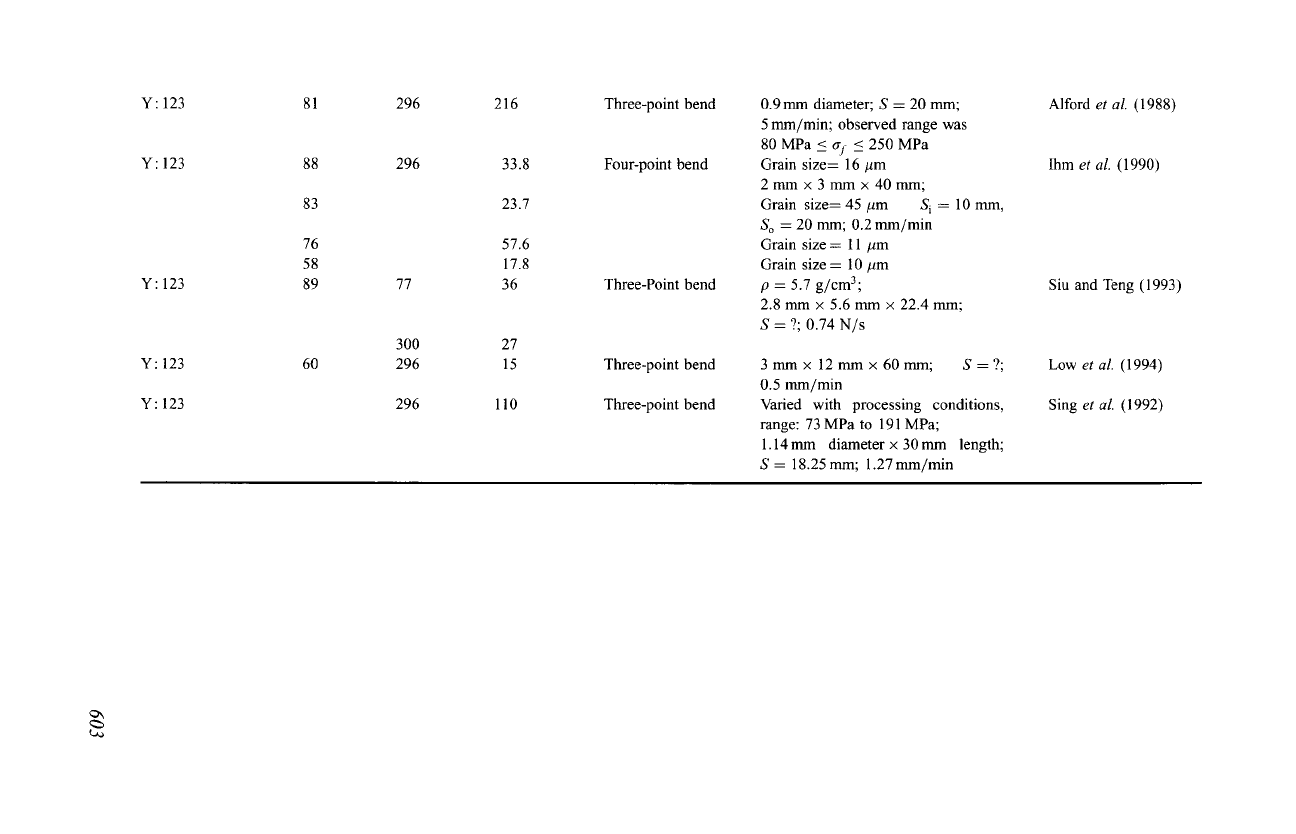
Y" 123
Y" 123
Y" 123
Y" 123
Y" 123
81
88
83
76
58
89
60
296
296
77
300
296
296
216
33.8
23.7
57.6
17.8
36
27
15
110
Three-point bend
Four-point bend
Three-Point bend
Three-point bend
Three-point bend
0.9 mm diameter; S = 20 mm;
5 mm/min; observed range was
80 MPa _<
O'f
~ 250 MPa
Grain size= 16/~m
2 mm x 3 mm x 40mm;
Grain size= 45 #m S i = 10 mm,
S o = 20 mm; 0.2 mm/min
Grain size= 11 ~tm
Grain size = 10 #m
p = 5.7 g/cm 3"
2.8 mm x 5.6 mm x 22.4 mm;
S = ?; 0.74 N/s
3mmx 12mmx60mm; S=?;
0.5 mm/min
Varied with processing conditions,
range: 73 MPa to 191 MPa;
1.14 mm diameter x 30 mm length;
S = 18.25 mm; 1.27 mm/min
Alford
et al.
(1988)
Ihm
et al.
(1990)
Siu and Teng (1993)
Low
et al.
(1994)
Sing
et al.
(1992)
ta~
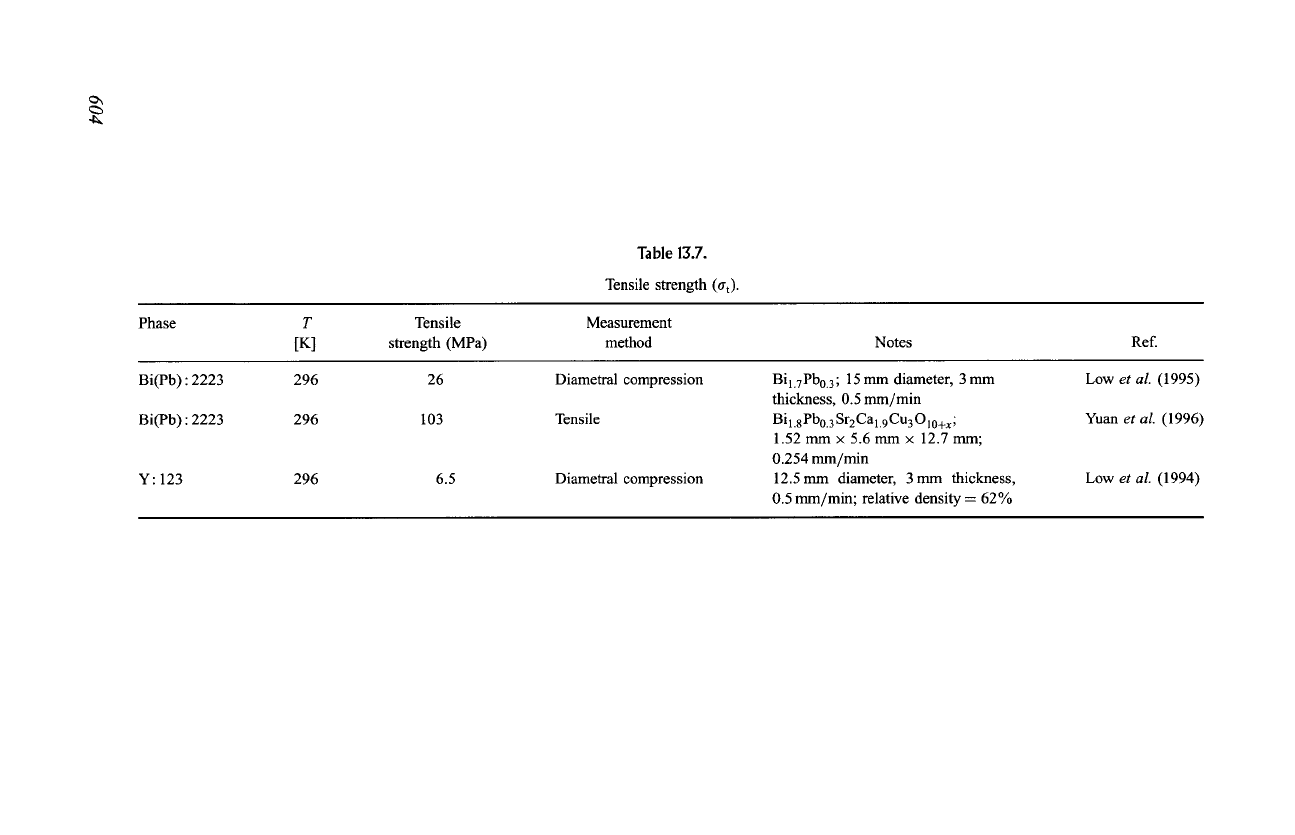
Table 13.7.
Tensile strength
(fit)"
Phase
T
[K]
Tensile
strength (MPa)
Measurement
method
Notes
Ref.
Bi(Pb):2223
Bi(Pb) : 2223
Y: 123
296
296
296
26
103
6.5
Diametral compression
Tensile
Diametral compression
Bi 1.7Pbo.3; 15 mm diameter, 3 mm
thickness, 0.5 mm/min
B i 1.8 Pbo.3 Sr2 Ca 1.9 Cu3 O 10+x;
1.52
mm • 5.6 mm
• 12.7
mm;
0.254 mm/min
12.5 mm diameter, 3 mm thickness,
0.5 mm/min; relative density--62%
Low
et al.
(1995)
Yuan
et aL
(1996)
Low
et aL
(1994)
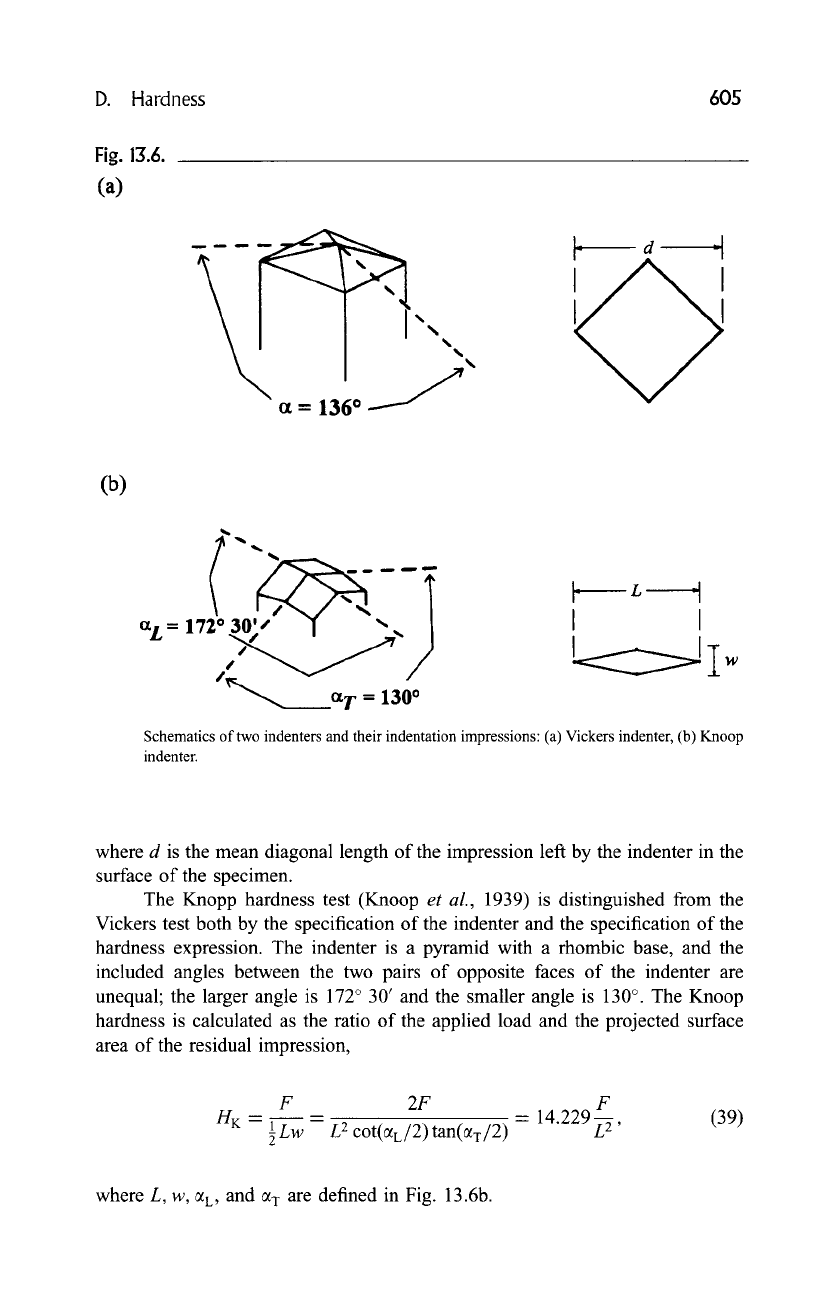
D. Hardness 605
Fig. 13.6.
(a)
m m m ~
,.,.
a = 136 ~ J
V
I I
(b)
/,~~
cz T = 130 ~
I_ L' ' "J
I- q
I I
t<:Z:: Iw
Schematics of two indenters and their indentation impressions: (a) Vickers indenter, (b) Knoop
indenter.
where d is the mean diagonal length of the impression left by the indenter in the
surface of the specimen.
The Knopp hardness test (Knoop
et al.,
1939) is distinguished from the
Vickers test both by the specification of the indenter and the specification of the
hardness expression. The indenter is a pyramid with a rhombic base, and the
included angles between the two pairs of opposite faces of the indenter are
unequal; the larger angle is 172 ~ 30' and the smaller angle is 130 ~ The Knoop
hardness is calculated as the ratio of the applied load and the projected surface
area of the residual impression,
F 2F F
H K 1L w
L2 cot(c~L/2) tan(c~T/2) 14.229L2, (39)
where L, w, %, and a T are defined in Fig. 13.6b.
